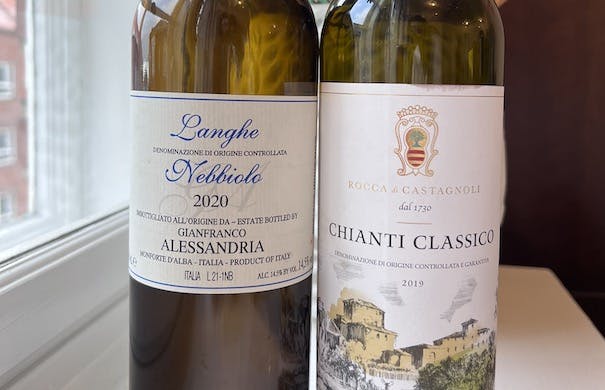Context Is Key: Sangiovese Versus Nebbiolo
Considering Italy’s heavy influence on our wine-buying habits, there seems to be a lot of misunderstanding regarding two of its most famous grapes.

Italy is vying with France for the title of the most important wine-making country in the world. More of its wine is imported into the U.S. than any other, twice as much as its northern neighbor, though the latter country’s wine value is overall slightly higher. Considering Italy’s heavy influence on our wine-buying habits, there seems to be a lot of misunderstanding regarding two of its most famous grapes: Sangiovese and Nebbiolo.
Sangiovese is the main grape used in Chianti. The name “Chianti” may just be the most notorious wine in the United States, thanks in large part to a particular film. Besides, as an accompaniment for fava beans, its mention often brings to mind their old-fashioned, tear-drop-shaped, straw-wrapped fiasco bottles. These circa-14th century padded orbs are still available, but as a marketing gimmick. You will be hard-pressed to find drinkable wine out of them.
Unfortunately, the name of the region itself is made doubly confusing, because there are actually two distinct regions with nearly identical names: Chianti Classico is one, and it’s set in the middle of Chianti.
The original, or “classico,” region was established in the 13th century, and it’s from where most of the superior wines emanate. Chianti was a copy-cat, spreading for miles in every direction and completely surrounding the original, forcing the Classico region to be officially re-delineated in 1716, in order to hold on to its storied status. Although some of the villages situated in Chianti can make some great wines at very fair prices, many are from inferior terroir and destined for inexpensive or bulk wine production.
Sadly, horror movies, packaging gimmicks, and having two regions so closely linked dilutes the quality and reputation of superior Chianti Classico wines. The producers there have to work twice as hard to distinguish themselves, a task made even more difficult in a foreign language in export markets.
Luckily, it is what is inside that counts, and our bottle choice of Rocca di Castagnoli, Chianti Classico, 2019, was a perfect example of how fantastic these wines can be. Mostly Sangiovese with a dash of Canaiolo and Colorino, it was a typical but precise expression of what one should expect from the lauded region.
Tart cherry and just-ripe strawberry fruit gush out of the nose, bolstered with a sharp acidity and sandy, round tannins are present but well integrated. The finish is predominantly stoney, not particularly long, but pleasantly perfumed with roses and a touch of sea salt. There is a purity of place shown through both the kiss of Tuscan sun and the minerality of limestone soils.
Rocca di Castagnoli is a large, family-owned estate in the village of Gaiole. Because of its size, it is able to select grapes from across a diverse collection of vineyards, from high and low altitudes, with different expositions with both clay and Alberese, the local name for their famous limestone soils. The elevage is a mix of modern and traditional, with fermentation in steel to retain some of the beautiful fruit notes, but then aged in large, neutral oak casks to allow for optimum cohesion of structure, avoiding any overt oak flavors of vanilla or baking spices.
This was a fun example to spring on my tasting panel (no wine nerds this round), who all had preconceived notions of what to expect from Chianti. Namely for it to be sour, harsh, or vinegary, only to find a pleasantly bright, lightly fruit, and overall balanced wine. It was also a great option to compare to wine two, Gianfranco Alessandria, Langhe Nebbiolo, 2020, a very typical example of its style as well.
Piedmont, where Alessandria is situated in Langhe, has always been something of an enigma for me: home to Italy’s greatest wines, but less well known or understood by the general public than Chianti.
Barolo and Barbaresco, neighboring superstar subregions, are considered by many connoisseurs to be some of the best red wines in the world, if not the best. But Nebbiolo’s supercharged intensity — high acid, high tannin, high alcohol, plus non-fruit flavors of tar and roses — make it much more difficult to get into or appreciate for the average person, myself once included.
If Chianti is the wine of the people, Barolo is the wine of the elite. The difference in pricing also doesn’t help, with the average Barolo starting around $50 and the average Chianti Classico at about $25. Thankfully, there is an alternative to Barolo, less well known, less expensive, but with many of its fine features: Langhe Rosso, or sometimes labeled Langhe Nebbiolo.
Langhe Nebbiolo is often made with younger vines or from less esteemed plots. It’s built for earlier and easier drinking. What I find very interesting is that in blind tastings, Chianti or Sangiovese is often confused with Nebbiolo or one of its proper-nouned sources (Barolo, Barbaresco, Carema, Valtellina, etc.). That’s why I wanted to compare the two side by side.
Alessandria’s Langhe Nebbiolo was another pitch-perfect example of the early-drinking Nebbiolo. Everyone on the panel, except me, preferred the fruit-driven, structurally tempered Chianti. Six years ago, before a trip to Piedmont, I would have said the same thing. It took years of tuning my palate to appreciate structure over flavor, which takes practice and exposure, in order to eventually find the appeal in Nebbiolo.
When drunk next to each other, the differences in the two wines was stark. Both were good, but the effect made on the non-professional wine drinkers made their overall impressions easy to remember: Strawberry and freshness for the Chianti, earthier and more tannic for the Nebbiolo.
For next month, we are going to take a look at terroir. To do this you can pick any two wines by the same winemaker, from the same vintage, at the same quality level, with the same grape variety, but from two different sites. I will be using: Bonnet Cotton, Fleurie, 2021, and Bonnet Cotton, Côte de Brouilly, 2021 (from the winery formerly known as Pierre Cotton).

